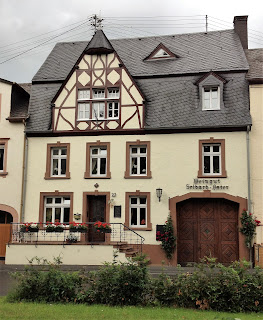Have I ever mentioned that I love Spain? (déjà vu…? see November 2016 post “Spanish Love Affair”)
In north-central Spain, off of the AP-68, in the middle of nowhere in the Ebro River Valley, is a place called Rioja. Maybe you’ve heard of it? Of course you have. Rioja is the King of Spanish wines.
Long
live the King !
Grape growing in this region dates back to 1000 BC (Phoenicians!),
and winemaking in Rioja has continually adapted and evolved throughout the changing
times.
Some say the area is named for one of the tributaries that
splits off of the Ebro River, the Rio Oja. Historically, grapes grown
in each of the three sub-regions of Rioja (Rioja Alta, Rioja Alavesa and Rioja
Oriental) were blended together. However, each sub-region has its own character,
with different elevations, soils and microclimates, and in the present day, many Rioja
winemakers prefer to highlight this uniqueness
by bottling their Rioja by sub-region. Add to this a strict hierarchy based on
ageing, and Rioja wines have a wide breadth and depth of styles to choose from. And don’t forget, they don’t just make red
wines in Rioja, but also white, rosé -- and even sparkling !
Part 1: Remelluri in the town of Bastida, sub-region of Rioja Alavesa.
Records show grapes have been
grown here since 1596. The Remelluri
winery was established in 1967 by the father of present
Named for an ancient 10th
century necropolis in the area, Telmo told us that Remelluri is located in the
highest elevation in Rioja. Side note: when
we left Barcelona, I was wearing a t-shirt and sandals; now up in the mountains, I had to
stop to buy socks and a sweater at a local flea market. Brrrr! The advantage of that cool mountain air in an
otherwise warm and sunny climate means long, slow grape ripening, adding freshness
and acidity to the wines made here and ensuring long ageing potential.
Telmo took us on a walk through
the organically farmed vineyards (certified since 2014), where his sister Amaia
encourages biodiversity by allowing other plants to grow between the rows of
grapevines. She also practices biodynamic
viticulture, integrating the Remelluri vineyard as one small part of the larger
ecosystem of the land.
 |
| A stroll through Remelluri vineyards |
After trying several of the Remelluri wines, we had a delightful lunch of chuletas de cordero (lamb chops). Telmo opened a 2005 Remelluri Rioja Reserva which was bright yet rich with ripe red berries, sweet spice and cracked black pepper, and was a perfect pairing with our meal. Then he surprised us by opening a 1982 Remelluri Rioja Reserva, which was delicate but intense with dusty black cherry, dried mountain herbs, cocoa, tobacco and ageing gracefully.
In a word: magic.
Before we departed, Telmo left us with his vision for the future of Remelluri. He wants to respect and “listen” to what came before. He has begun to pick grape varieties that are best suited for the specific microclimates of each vineyard plot. He declared that "new is not always better" and explained that he is refocusing on older trellising styles and more bush-vine training to limit yields, resulting in more concentration in the wines. And that what is most important is to let the terruño (or, terroir) speak for itself.
His motto: “The future lies in the past.”
Remelluri, Carretera Rivas de Tereso, 01330 Labastida, Spain
















